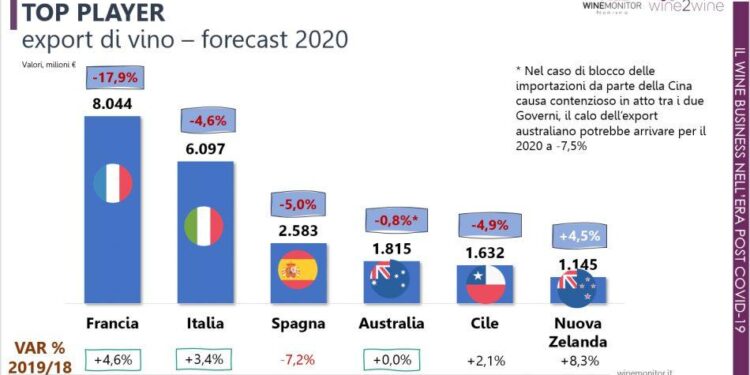The Future of Italian Wine Exports: Overcoming Tariff Obstacles
Recently, Italian wines have garnered immense recognition on a global scale, with exports to the United States soaring to an notable $2 billion. Nevertheless, the looming threat of tariffs presents a significant challenge to this flourishing market, casting doubt on the future accessibility of Italian wines for American consumers. As trade tensions rise between the U.S. and Europe, Italy’s wine producers are bracing for potential impacts that could jeopardize their profitability and disrupt the cultural exchange that fine wines represent. This article delves into the intricacies surrounding tariff implications, responses from Italy‚Äôs wine industry, and broader effects on international trade dynamics‚ÄĒproviding insights into how these developments may reshape one of the world‚Äôs most beloved beverages.
Impact of Tariffs on Italian Wine Exports
The implementation of increased tariffs on Italian wine exports to America could have profound consequences for both producers and consumers. For winemakers in Italy, rising costs may lead to a notable decline in export volumes as American buyers might turn towards local or non-Italian options to avoid higher prices. Some immediate repercussions could include:
- Decreased Revenue: The additional tariffs could considerably squeeze profit margins, impacting both small vineyards and larger commercial operations.
- Market Share Loss: Competitors from countries with lower tariff rates might capitalize on opportunities that Italy risks losing.
- Consumer Behavior Changes: Higher prices may deter U.S. customers from purchasing Italian wines, resulting in reduced overall demand.
The consequences extend beyond financial metrics; they threaten Italy’s rich viticultural heritage and agricultural practices as well. Given that a substantial portion of Italian wine is exported across the Atlantic Ocean,these changes could dramatically alter production landscapes. Potential long-term outcomes include:
- Cuts in Investment: A revenue decline might compel wineries to scale back investments aimed at technological advancements or sustainable practices.
- Job Losses: A downturn in exports can result in job cuts across various sectors within the wine industry‚ÄĒfrom vineyard workers to distribution networks.
- Evolving Brand Image: Ongoing trading challenges may gradually shift consumer perceptions regarding the desirability of Italian wines over time.
Economic Impact on Italy’s Wine Industry
The prestigious wine sector in Italy faces potential disruption primarily due to an evolving economic landscape influenced by export tariffs. Generating approximately $2 billion annually,any alterations in trade agreements with key markets like America can profoundly affect this industry. Import restrictions frequently enough lead to higher consumer prices which can dampen demand‚ÄĒnot only affecting large vineyards but also smaller producers who rely heavily on international sales channels. Should these tariffs escalate further,it would undermine any competitive advantages held by Italian wines within U.S markets necessitating adjustments in pricing strategies and consumer accessibility.
This impact transcends immediate sales figures; several factors are likely affected by forthcoming tariff implementations including:
- Sourcing Challenges: Changes imposed by import policies may cause delays or incur additional costs related to shipping logistics.
- A Shift in Competitive Landscape: Domestic U.S.-based wineries might seize this chance gaining market share at Italians’ expense.
- Redirected Investments: Producers may pivot towards emerging markets reducing their reliance upon traditional ones like America .
Area Affected Expected Outcome Tariffs Increased import expenses Consumer Pricing Elevated retail costs Sales Volume < td
Projected decreaseA number of producers throughout Italy are closely monitoring potential fallout from increased tariffs while considering innovative strategies aimed at mitigating risks associated with maintaining their presence within American markets. Strengthening direct-to-consumer channels , enhancing marketing initiatives , along diversifying product offerings represent effective tactics capable navigating through unfolding economic ripples . In an industry where heritage alongside quality reign supreme , resilience among Italians will undoubtedly be tested as they adapt amidst shifting trade relations alongside evolving consumer preferences .
Strategic Adaptations from Producers Amidst Tariff Challenges
Navigating heightened tariff realities necessitates strategic adaptations among Italian winemakers if they wish not only survive but thrive during uncertain times ahead . First off , diversifying target markets has become essential ; looking beyond conventional destinations such as United States allows them mitigate risks tied fluctuations seen within current policies . Effective tactics include :
- > Expanding into Asian Markets : Growing interest surrounding premium-quality italian varietals found countries like China Japan opens new revenue streams .
- > Building Partnerships : Collaborating local distributors emerging regions facilitates smoother entry adaptation processes .
- > Leveraging E-commerce : Increasing online sales platforms enables direct access customers bypassing some adverse impacts stemming from tariffs .
Beyond simply expanding geographical reach , italian wineries focusing enhancing product appeal value proposition too ; crafting unique offerings emphasizing quality heritage justifies premium pricing even amidst economic pressures faced today tactics achieving goals include :
- > Investing Branding Efforts : Strengthening brand identity storytelling sustainability traditional practices enhances connection between producer consumer.
- > Targeting Niche Segments : Focusing high-end specialty markets allows capitalize willingness pay more authenticity .
> > Strategy > Description > >> > Market Diversification > Targeting new geographical areas such Asia online platforms. > > > Brand Enhancement > Creating compelling narrative centered around quality heritage. > >Conclusion
As global economies navigate complex trade dynamics implications arising out heightened duties placed upon italy’s exported products remain far-reaching indeed ! Renowned Siracusa vineyards known exceptional craftsmanship face significant challenges posed financial strains resulting increased levies imposed upon them ! Stakeholders ranging growers distributors must stay vigilant adaptive negotiations evolve continuously ensuring fair practices benefit all parties involved transatlantic relationship remains intact! As situation unfolds it promises serve pivotal case study interplay agricultural policy international commerce!
ADVERTISEMENT - > Targeting Niche Segments : Focusing high-end specialty markets allows capitalize willingness pay more authenticity .
- > Building Partnerships : Collaborating local distributors emerging regions facilitates smoother entry adaptation processes .
- Redirected Investments: Producers may pivot towards emerging markets reducing their reliance upon traditional ones like America .
















